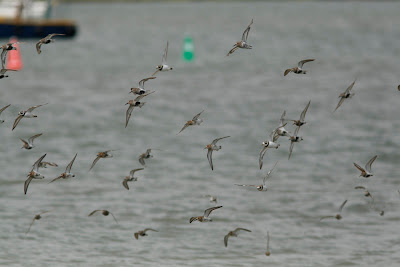


Highlight of the day was a juvenile Knot on the enclosed beds accompanied by the four Ringed Plovers, one juvenile Wood Sandpiper and 5 Common Sandpiper. Of the 19 records of Knot (this one the 20th if there were no records in 2006-7) at Beddington (before 2005), August has proved to be the peak month with four records (this is now the fifth August record).
According to HBW there are five sub-species of Knot, C.c canutus (CN Siberia), rogersi (Chukotskiy Peninsula south to Australia), roselaari (Alaska), rufa (Canadian low Arctic) and islandica (islands of Canadian High Arctic and N Greenland). The main population which winters in W Europe is islandica. However canutus may pass through the UK on the way to their wintering grounds in Africa and some may halt in W Europe. So this bird is presumably islandica but could be canutus. Canutus generally congregate in the Wadden Sea before flying non stop to Africa. The vast majority of Knot in the UK are islandica.
Well if this has come from Greenland or Canada, than that means maybe the Ringed Plovers did too- so not safe to assume they are from the northern european populations, which seems logical to assume. Adult islandica are more spangled on the upperparts with less intense red colouration below. However this juvenile plumaged bird is presumably inseperable. It would be very interesting to know, which race and thus where this bird originated. Either way- Russian, Canadian or a Greenlander- it is pretty amazing that is has found its way to a pit of human excrement in London.
Knots are famous for epic journeys including single flights of over 5000km. The Wadden Sea is very important in this birds ecology as a major staging and moulting area.
1 juvenile Knot, 4 (2 adults, 2 juveniles) Ringed Plover, 7 Common Sandpiper, 4 Green Sandpiper, 1 juvenile Wood Sandpiper, 1 Barn Owl (flushed from elder bushes), 1 1st win Wheatear on top soil mound, 60+ Swift, 20+ House Martin, 45 Ring-necked Parakeet,

























